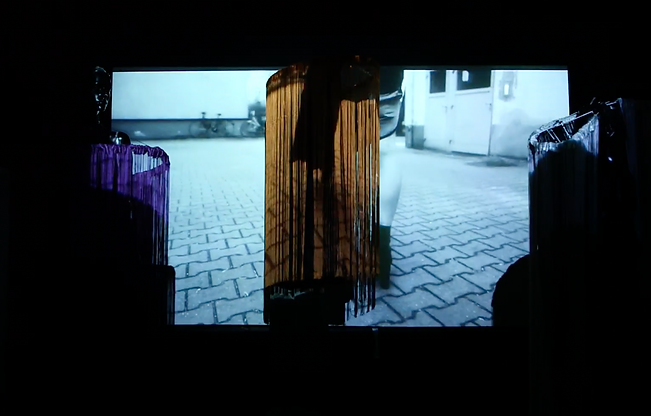Beyond Seeing
Beyond Seeing is a research and exhibition project that explores and suggests alternative design methods: sonic, tactile, kinaesthetic and olfactory

The research project Beyond Seeing: Innovative Ways of Sensory Fashion Design was initiated by Goethe’s Institute in Paris in co-operation with four renowned fashion schools: ESMOD (Germany), IFM (France), The Swedish School of Textiles (Sweden) and La Cambre (Belgium), as well as associations for the visually impaired and the blind such as Visually Impaired Youth (Sweden), VIEWS International (Belgium), Deutscher blind und Sehbehindertenverband (Germany) and the Fédération des Aveugles (France). Within the scope of several international research workshops, an exhibition and a discursive accompanying program, the project was intended to make fashion discernible beyond the visual stimuli through the interaction of sensory perceptions.
Different target groups who never met before - students of design, blind and visually impaired participants, as well as experts of different artistic disciplines - were brought together for the first time in order to develop innovative design concepts.
Funding body and coordinator: Goethe Institut Paris
Swedish funding: City of Borås.
touch
research workshop at ESMOD, Berlin
Participants: Reiner Delgado, Jette Förster, Verena Kuen, Valentin Mogg, Antje Samoray, Maximiliane Tilch, Noemi Walker, Joyphie Yu
The participants from Berlin under the supervision of Professor Thorbjorn Uldam were mainly addressing the question of whether fashion design beyond a visual perspective is possible at all. The students drew inspiration from the exchange with visual impaired participants and developed experimental design approaches. In their research they were particularly focusing on the tactile perception, the sense of touch, reflected by the use of unusual materials, like organza or so. The students presented their first drafts in front of a non-seeing jury.
Text and image credits: Goethe Institut Paris

smell
research workshop at IFM, Paris
Participants: Kevin Brugneaux, Priscilla Dauriac, Ellie-Grace Frost, Fabienne Haustant, Allison Juchnevicius, Jeanne Okretic, Alexandra Perestrelo
The central question of the research-workshop in Paris under the supervision of Professor Hans de Foer was about the connection between fashion design and the olfactory sense. Based on this positioning students together with non-seeing participants tested through interactive exercises numerous design approaches and experienced that smell and identity are clearly interconnected.
Text and image credits: Goethe Institut Paris

movement
research workshop at La Cambre, Brussels
Participants: Elisa Defossez, Jonathan Lambert, Hugo Paternoste, Jean-Luc Pening, Marilys Tran The Tri, Yann Vajda, Sarah Willemart
The Belgian participants under the supervision of Professor Marion Beernaerts chose as starting point the non-seeing body in space. On that basis they developed on the border of art and industrial design strategies and objects aiming to counteract the disorientation provoked by blindness. During the workshop these strategies and objects were experienced and discussed by seeing as well as non-seeing participants.
Text and image credits: Goethe Institut Paris

sound
research workshop at The Swedish School of Textiles, Borås
Participants: Linda Aasaru, Rugilė Gumuliauskaitė, Elin Holm, Dana Jasikeviča, Irma Jokštytė, Emma Lindh,
Stina Randestad, Lynn Tallvod
Research workshop lead: Vidmina Stasiulytė
The Swedish research workshop focused on the sense of hearing. Not in a narrow sense, but expanded in such a way that the human body was considered a resonating body. Under the supervision of Professor Clemens Thornquist and doctoral student Vidmina Stasiulytė and based on acoustic experiences the participants fathomed multiple creative opportunities. This generated innovative fashion-sound-concepts.
Text and image credits: Goethe Institut Paris

creation workshop
research workshop at ESMOD, Berlin
The Creation Workshop gave all 50 participants the chance to present the concepts developed in the
respective research workshops and reflect on the experiences made. Afterwards, they collaboratively developed concrete ideas and concepts for an interactive, modular and sensory exhibition design. Maintaining a focus on interaction and direct experience, the workshop featured immersive spatial presentations from the participating architecture students as well as a visit to König Gallery and a talk with its founder Johann König, who became one of the world’s most influential gallerists despite his visual impairment.
Text and image credits: Goethe Institut Paris

exhibition
research final exhibition at WIP, Parc de la Villette, Paris
The project BEYOND SEEING was presented for the first time in a transdisciplinary and interactive exhibition in 18-28 January 2018 in Paris. The exhibition aimed on creating a multisensory experience. The visitors – seeing or not seeing – touched, heard, smelled and tasted as well as experienced and interpreted fashion beyond the visual aspect. A broad discursive accompanying program was planned, which provided an artistic, scientific as well as future-oriented exchange on the basis of the concrete experience made during every phase of the project.
Conception of the exhibition’s architecture
Until the grand opening of the exhibition all participating students finalize their designs in close exchange with the blind and visually impaired participants. At about the same time Scenography workshops are held with architecture students of the University of Applied Sciences and Technology from Wismar; Germany, Professor of experimental design Julian Krueger is in charge of the conception and realization of a modular and sustainable exhibition architecture.
Text and image credits: Goethe Institut Paris
